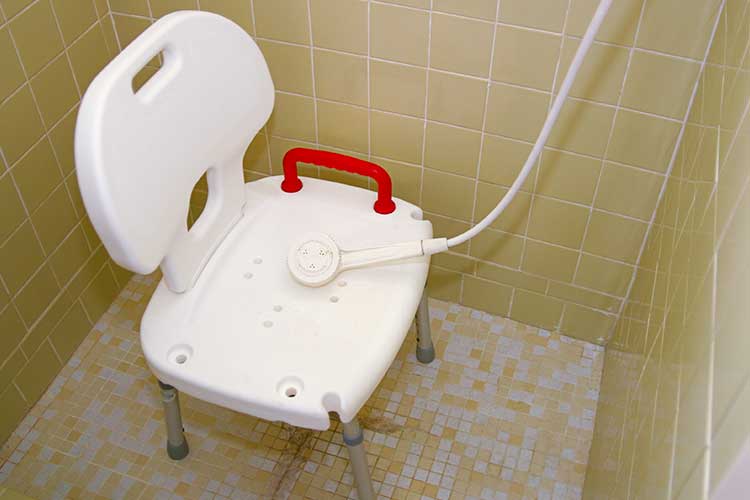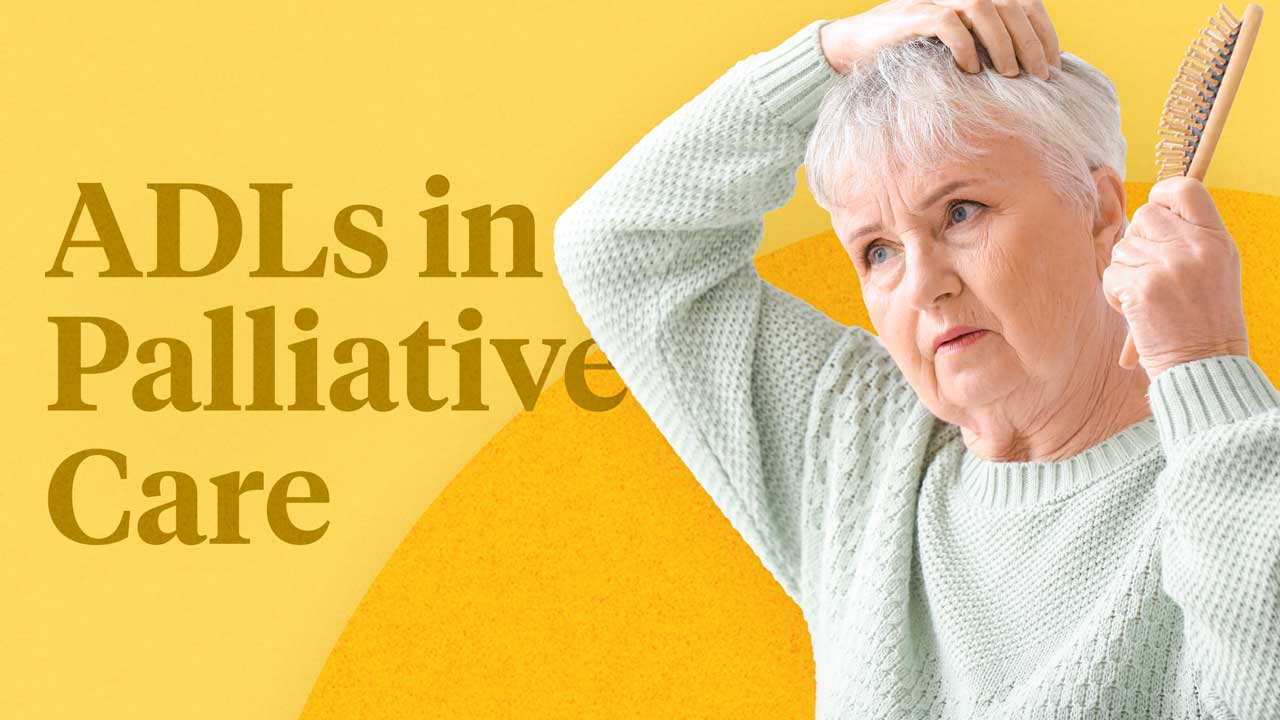Part of being involved in a person’s palliative care journey means assisting in improving the person’s quality of life.
This requires you to not only monitor and address the person’s clinical needs but also to consider the importance of their ability to complete or participate (as able) in basic activities of daily living (ADL).
What are Activities of Daily Living (ADLs)?
Read: An Introduction to Activities of Daily Living (ADLs)
The term activities of daily living (ADLs), which was created by Sidney Katz in 1950, refers to the fundamental life skills that someone must be able to perform in order to independently care for themselves (Edemekong et al. 2025).
Being able to perform ADLs is an indicator of functional status. Someone who struggles with ADLs is likely to experience a poorer quality of life, depend more on other people and mobility devices, and live with a risk of harm if not properly cared for (Edemekong et al. 2025).
ADLs can also assist in determining whether someone requires extra support, for example, home care or admission to an assisted living facility (Edemekong et al. 2025).
A change in a person’s capacity to perform ADLs might indicate unmet needs, which, if not properly addressed, can lead to consequences such as malnutrition, acute illness (e.g. infection) and falls (Huntsberry-Lett 2023).
There are two types of ADLs:
- Basic ADLs - the skills required to meet one’s fundamental physical needs. These include ambulating, feeding, dressing, personal hygiene, continence and toileting.
- Instrumental ADLs - more complex tasks that allow a person to live independently in the community. These include transportation and shopping, managing finances, shopping and meal preparation, house cleaning and home maintenance, communicating with others, and managing medications.
(Edemekong et al. 2025)

How Can Life-Limiting Illness Affect Activities of Daily Living?
Life-limiting illness may make it more difficult for a person to perform ADLs due to a variety of factors, such as:
- Feeling generally unwell and fatigued
- Side effects such as nausea, loss of appetite, constipation, pain and xerostomia (dry mouth)
- Decreased physical capacity caused by musculoskeletal, neurological, circulatory or sensory conditions
- Cognitive impairment
- Social isolation
- Medication side effects
- Episodes of acute illness
- Admission to hospital
- Loss of flexibility or dexterity, which can make it more difficult to perform tasks such as dressing oneself
- Reduced balance and coordination
- Reduced energy
- Fear of falling or injury.
(Better Health Channel 2017; Edemekong et al. 2025; Bursack 2019)
Why are Activities of Daily Living Important in Palliative Care?
Nobody wants to lose their independence.
Independence is inherently tied to dignity and confidence, and losing it, especially suddenly, can have a profound impact on self-esteem and quality of life.
As a healthcare worker, your role is to help those in your care maintain as much autonomy as possible.
This has several benefits for care recipients, including improving their functional status and quality of life, allowing them to maintain their dignity, and helping to preserve their sense of identity (Saotome et al. 2018; Tavemark et al. 2019).
Healthcare providers must be able to adopt a flexible approach toward care assessment and developing care plans. The importance of being able to perform basic human needs activities (independently or with assistance) should be discussed as a viable goal for clients that you care for.
Often seen by care staff as activities that can easily be hurried, it should not be forgotten that being able to carry out daily tasks (which were often previously automatic tasks for the person) greatly impacts their self-worth and self-esteem. These activities can be an important goal and may also have implications for work, social life, relationships and the home environment. Engaging care recipients and their family members or caregivers in constructive conversations regarding care planning can be highly beneficial in alleviating feelings of powerlessness, loss of control and lack of choice, and thus help to boost morale and comfort.

Assessment Through the Trajectory of Illness
During an illness's trajectory, priorities change with the fluctuation of symptoms. Understanding and being aware of how risk factors affect the way that symptoms are expressed will help caregivers communicate with care recipients and determine their underlying needs. Continual assessment can help uncover the masquerading of symptoms and the person’s ability to participate in their daily activities.
Symptoms may be influenced by cognitive impairment or emotional distress. When someone says they feel fatigued, they may be depressed, or if they say they are anxious, they may also be suffering from pain or shortness of breath. Be aware of what your care recipients can achieve daily, remembering that the completion of a simple ADL task may be the emotional boost that is needed for that day.
Measuring Activities of Daily Living
A person’s capacity to perform ADLs can be assessed using the Resource Utilisation Groups - Activities of Daily Living (RUG-ADL) tool, which measures four ADLs: bed mobility, toileting, transfer and eating (DoHDaA 2025).
For more information on how to use the RUG-ADL tool, see the Ausmed Article An Introduction to Activities of Daily Living (ADLs).
Assisting with Activities of Daily Living in Palliative Care
For more information on how to use the RUG-ADL tool, see the Ausmed Article An Introduction to Personal activities such as bathing, dressing, personal hygiene and grooming may be achieved with the use of assistive devices, adapting the care environment to suit the person’s needs or prioritising activities.
For example, a person who has difficulty dressing due to decreased dexterity might find it easier to put on clothing with elastic waistbands, velcro fasteners and magnetic closures rather than those with buttons or zips. Using more adaptive clothing may therefore allow the person to continue dressing on their own instead of relying on others (Bursack 2019).
Furthermore, grab bars, non-slip mats and shower chairs may allow a person to bathe more independently whilst reducing the risk of injury (Bursack 2019).

Care recipients may have difficulty feeding due to the symptoms of their illness and/or treatment side effects, including nausea and loss of appetite. Offering the person foods they enjoy in small amounts may encourage them to eat. Towards the end of life, ensuring that meals are healthy and balanced becomes less important. Maintaining oral hygiene can also help to make eating a more comfortable experience (Better Health Channel 2017).
Household activities, including housework and leisure activities (e.g. watching television or exercising), may be achieved by retraining actions or providing help, thus sustaining self-reliance for the more important tasks. Adapting the environment to suit the person’s needs can also be beneficial.
Helping the person and their loved ones understand the importance of maintaining their role in the family during the illness and being involved in family decisions will assist with the person’s emotional wellbeing.
Setting up work areas or rearranging room functionality can help the person continue to participate in work, rehabilitation and self-training programs.
Referral to other healthcare professionals (such as occupational therapists) will allow caregivers to use their expertise to assess the person’s physical needs, which will, in turn, boost the person’s psychological status.
Conclusion
Loss of the ability to complete ADLs is often emotionally and physically distressing and may lead to a decrease in self-worth. Caregivers who are acutely aware of and place special emphasis on a person’s changing needs will be able to assist them to prioritise goals and plans. Care should be continually revised and quickly assessed to cater to these changes.
Planning ahead with care recipients and relatives when required will also enable care contingencies to be easily adapted as indicated, allowing for a smooth transition in changing circumstances.
Test Your Knowledge
Question 1 of 3
Which one of the following is the most appropriate approach to mealtimes in palliative care?
Topics
Further your knowledge
 Free
Free Free
Free



References
- Better Health Channel 2017, Providing Practical End of Life and Palliative Care at Home, Victoria State Government, viewed 7 July 2025, https://www.betterhealth.vic.gov.au/health/servicesandsupport/Providing-practical-end-of-life-and-palliative-care-at-home
- Bursack, CB 2019, ‘The Importance of Activities of Daily Living (ADLs)’, Senior Issues, viewed 7 July 2025, https://www.creativecaregiversfl.com/senior-issues/activities-of-daily-living-why-this-measure-matters/
- Department of Health, Disability and Ageing 2025, AN-ACC Reference Manual, Australian Government, viewed 7 July 2025, https://www.health.gov.au/resources/publications/an-acc-reference-manual-and-an-acc-assessment-tool?language=en
- Edemekong, PF, Bomgaars, DL, Sukumaran, S & Schoo, C 2025, ‘Activities of Daily Living’, StatPearls, viewed 4 July 2025, https://www.ncbi.nlm.nih.gov/books/NBK470404/
- Huntsberry-Lett, A 2023, ‘Understanding Activities of Daily Living: Checklists, Assessments, and More’, AgingCare, viewed 7 July 2025, https://www.agingcare.com/articles/activities-of-daily-living-why-this-measure-matters-186853.htm
- Saotome, T, Iwase, S, Nojima, M, Hewitt, B & Chye, R 2018, ‘Assessment of Activities of Daily Living and Quality of Life Among Palliative Care Inpatients: A Preliminary Prospective Cohort Study’, Progress in Palliative Care, vol. 26, no. 1, viewed 7 July 2025, https://www.tandfonline.com/doi/abs/10.1080/09699260.2018.1427677?journalCode=yppc20
- Tavemark, S, Hermansson, LN & Blomberg, K 2019, ‘Enabling Activity in Palliative Care: Focus Groups Among Occupational Therapists’, BMC Palliative Care, viewed 7 July 2025, https://bmcpalliatcare.biomedcentral.com/articles/10.1186/s12904-019-0394-9
 New
New 
